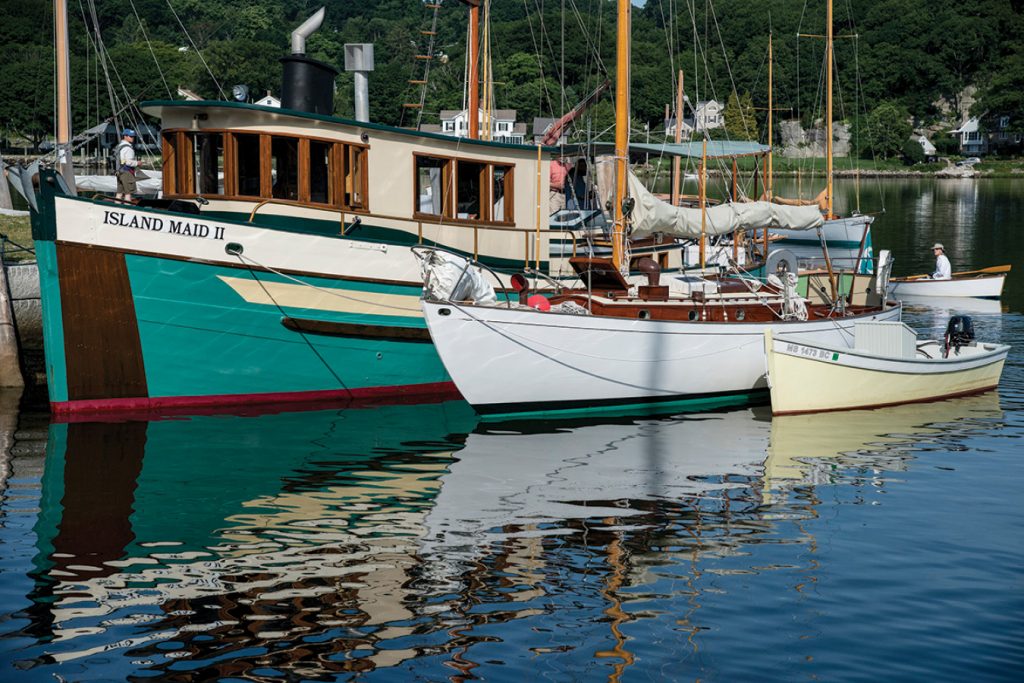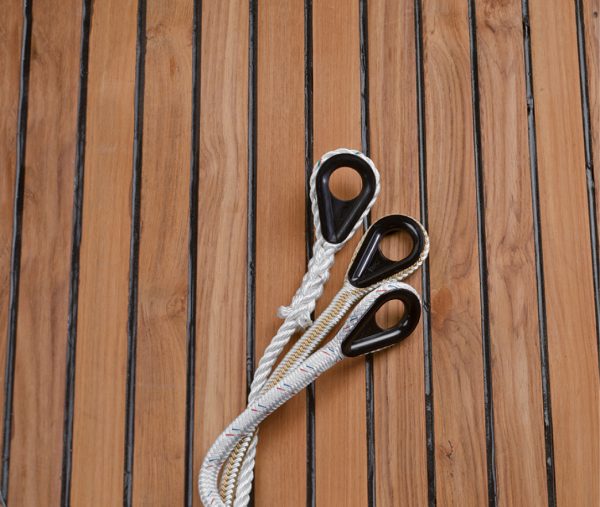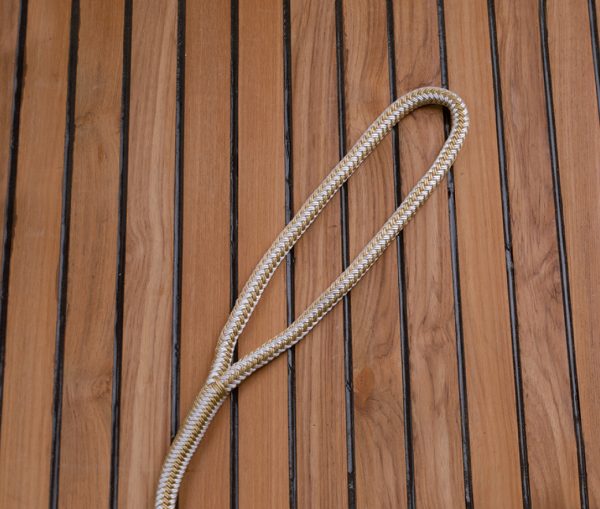Presented by Samson Ropes

Rafting up with vessels with different freeboards can be particularly challenging, so choose lines carefully and use plenty of chafing gear. ©Mysticseaport.org
As boaters, we are often casual about the lines we use to secure our boats to docks, piers, moorings or anchorages. Often times, boaters will spend more to fuel their boat than to secure it. With that in mind, it is highly important to find and purchase a top quality dock and anchor lines that will protect your investment.
Lines are made in a single braid or double braided construction, which means there is a core and a cover configuration to the line. In general, double braids outperform single braids due to the additional mechanism of the protecting jacket sharing the weight of the core. There is also a simpler three-strand construction when considering low-strength/low-cost requirements.
High-end dock lines are primarily constructed of Nylon, a synthetic fiber that has an excellent combination of strength and stretch, allowing for ebbs and flows in water and wind conditions to secure your boat when docked. Extended exposure to water, i.e. soaking, can result in the Nylon fiber shrinking and losing strength, though, so it is best to ensure that this is minimized.
How best to use dock and anchor lines when it really matters: in a storm
- Build in a backup plan: anticipate that one or more cleats or pilings will fail.
- Double up on dock lines or mooring lines.
- Use longer runs from dock/pier or piling to absorb shock loads and rising water levels.
- Inspect mooring cleats on both the dock and the boat for strong attachments and backing plates.
- Ensure you have spring lines for dock, pier and pier attachments to reduce surge and share the loads. Don’t rely on bow and stern lines alone in storm conditions!
- Chafe protection is critical
- Ensure that you have clear and fair leads from mooring cleats.
- Go the extra mile and add chafe gear at points of contact.
- Be willing to inspect lines before storms arrive and replace with the correct diameter to ensure strength and the proper bearing surface to reduce chafe.
- When on a mooring in a storm, be sure to run extra lines through the mooring ball that can be released from the deck in case the mooring ground tackle fails.
- When using anchors during a storm;
- Avoid open anchorages.
- Set multiple anchors to oppose the anticipated force of the storm (and potential changes in direction).
- Use land attachments if in a “hurricane hole” and ensure long and fair leads to the boat.
- Ensure all lines can be controlled from the boat if needed.
- Use chafe protection at the point(s) of attachment or lead.
- Consider using a bridle to attach the loaded anchor to the bow and the stern to offset loads and to position the boat to the prevailing wind(s).
- Double up on your standard chafe protection.
- Try to anticipate the storm direction and offset the winds and waves with attachments.
- Reduce the wind profile by removing fabric tops, dodgers, furling headsails (take them down and stow them below) and deck store tenders.
 From top to bottom are Samson’s Pro-Set 3-strand Nylon, Gold-N-Braid double braided Nylon and Super Strong double braided Nylon anchor lines. © SamsonRope.com |  Samson’s Gold-N-Braid double braided Nylon dock line has excellent stretch, flexibility and shock mitigation with a soft feel. © SamsonRope.com |
Lines for Rafting Up
Multiple lines are necessary to attach boats tighter for raft up moorings. Primary anchor boats must be using adequate anchors before the raft is started, and wind direction may require more anchors be set by a few boats. Lines led from bow to bow and stern to stern will secure the boats to each other, but do not “lock in place.” This is done with spring lines to minimize vessel movement fore and aft relative to each other.
The biggest challenge is with vessels with different freeboards. It’s best to raft to vessels with freeboard close to yours and consider the option of rafting bow to stern if deck flare or overhangs are a potential problem. If sailboats are rafted, consider the spar locations to ensure the masts avoid each other in the raft. Remember that the boats will be rocking back and forth so a bit of forethought is required.
Longer lines provide better elastic performance, and rafting up is not the time to use some “low stretch” line – as the result is damage to mooring cleats on both boats due to the shock loads transmitted through the lines. Again, consider chafe protection for the lines when rafting together.
The overall consideration for dock and anchor line performance is the prevention of chafe or overload, so choose wisely in size, consider the potential value of better performance (longer life) in double braided nylon products, and use chafe protection to ensure long life for your boat. ■
Samson Ropes is celebrating its 140th anniversary in 2019. As an innovator in rope technology, Samson produces rope at their manufacturing facilities in Ferndale, WA and Lafayette, LA. To learn more, log onto SamsonRope.com



